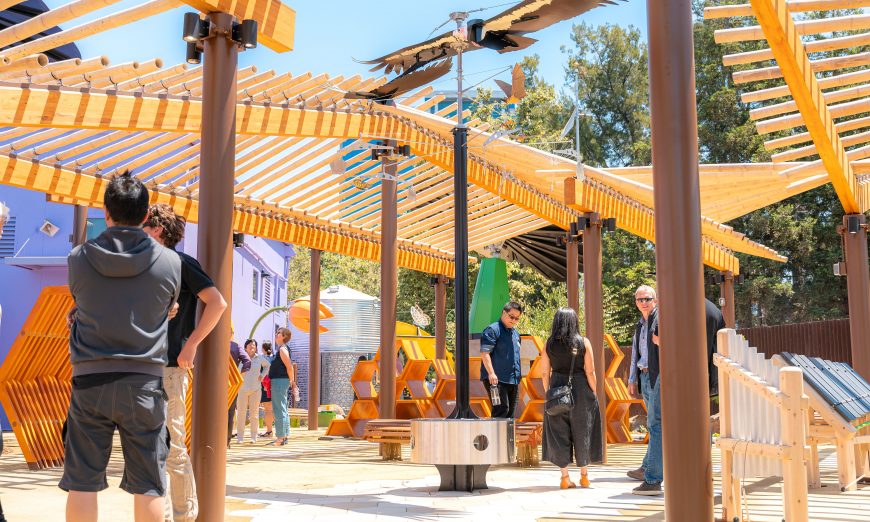Children’s Discovery Museum of San Jose is helping children discover patterns, proportion, scale, and symmetry at the intersection of math, science, and nature with its new outdoor educational play space. Exploration Portal’s eight interactive exhibits opened on June 13 and will provide endless opportunities for STEM-based discovery and learning in nature.
“Children learn through patterns, and by linking patterns, scale, proportion and symmetry to the things we see in nature, we’re helping children better understand the natural world,” said Marilee Jennings, executive director of Children’s Discovery Museum of San Jose.
“Thinking about patterns also helps children make sense of math and science, and we know that introducing these early in life nurtures critical thinking, problem-solving, and sets the stage for future academic success,” added Jennings. “STEM is a natural approach to early childhood education because children have an innate curiosity and STEM gives them tools to question, investigate, and hypothesize.”
In addition to STEM learning, sustainability and inspiring tomorrow’s environmental stewards were top of mind in designing the Exploration Portal. The space role models the use of drought-tolerant and native plants for biodiversity and water conservation while also improving the health of the Guadalupe River.
“Having the opportunity for Educare to partner with Children’s Discovery Museum for this amazing launch is really exciting,” said Santa Clara County Superintendent of Schools, Mary Ann Dewan. “Children learn best when they have hands-on experiences.”
Children’s Discovery Museum Exploration Portal Features
Having fun while learning continues to be the museum’s trademark. Exploration Portal invites full-body engagement, beginning with the Beehive Climber, a hexagon patterned structure modeled on a traditional beehive that kids will climb on, over and through to immerse themselves in pattern exploration. Whirling Flyers features objects both from the natural and created worlds and shows how they fly at different altitudes powered by kid-energy. Patterns Everywhere will mesmerize visitors with beauty and delight while discovering that the image is actually an intensive magnification of an ordinary strawberry or the wing of butterfly, for example.
With the Measure Me! exhibit, kids will use their own bodies as a measuring device and be surprised to learn that one’s forearm equals the length of their foot. Four Giant Kaleidoscopes with varying shaped viewing windows will allow children to investigate patterns in the surrounding environment, and Rocks that Sing, stone Xylophone-style instruments, will fascinate all who “play” the melodic sounds they make.
Three giant Smartflowers in space mimic the sun’s relationship to flowers, demonstrating how to harness efficient solar energy. The petals open when the sun rises and moves across the sky and fold up when the sun sets—all in dramatic and large-scale fashion.
The museum’s Smartflowers are the first to be installed in northern California.
Discovery Museum Sustainable Designs
The museum believes that turning a natural space into a created environment should deliver more benefit than it did originally, inspiring staff and project architects to create sustainable designs that support environmental stewardship.
The landscape and architectural designs improve the health of the Guadalupe River by mitigating toxic run-off, preventing pollution from entering the riparian corridor, and absorbing rainwater. Planted bioswales and overflow retention gardens feed aquifers and prevent pollution from vehicles, airplanes, and surfaces from entering the river. Drought tolerant plants with the most interesting patterns were selected that also meet Santa Clara Valley Water District’s guidelines for biodiversity near riparian locations.
Granitecrete permeable paving on all pathways allows stormwater to pass through and be absorbed into the ground underneath. Renewable wood is the preferred building material, including California-grown bamboo for the shade structure.
Exploration Portal Major Donors: title sponsor Xu Family Charitable Foundation, County of Santa Clara, FIRST 5 Santa Clara County, Google, Santa Clara Valley Open Space Authority, Santa Clara Valley Water District and Molly and Barry Swenson. The new space is adjacent to Bill’s Backyard and completes the southern border of the museum’s footprint.
Other Posts:
Kaiser Permanente Announces More Than $1 Million In Local Health Grants






